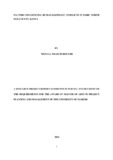| dc.description.abstract | Mount Kenya has 900 km2 of human settlements that adjoins the periphery of the Mount
Kenya Forest Reserve in a 2 - 10 Km wide belt, and extended from the town of Nanyuki in
the northern part towards the south and then eastward to the border between Embu and Meru
South Districts. Wildlife forms a great part of Kenyan economy in terms of foreign exchange
and good relations locally regionally and internationally. It’s of importance that of the big
five in Kenya, we have elephant, Loxodonta Africana Africana. Human wildlife conflicts
have been one of greatest threats to conservation since it has led to retaliatory killings,
negative perceptions of wildlife, loss of crops, human injuries, human deaths and poaching.
There are farm practices that have fueled these conflicts where there are some crops like
maize and cassava that have been proved to attract wildlife, in particular elephants to them.
The farm practices like shamba system where farmers do crop farming in the forests have
also ld to encounters with the wildlife hence in the event there are bound to be conflicts due
to intrusion. Wildlife barriers like electric fence, trenches and buffer zones are the indicators
which when considered would have an impact to human wildlife conflicts. Human
encroachment basically through the land use systems have had a major impact in reducing the
elephant habitat which results to raids and crop destruction. Elephant encroachment on
humans and crops has contributed to adaptive and reactive situations in and around protected
areas. This study used descriptive research design targeting particularly the communities and
households that live in Embu north and borders the Mount Kenya National reserve boundary
for the factors that influence human elephant conflicts, (HEC) in that area. The results of 382
respondents were subjected to analysis with the focus on factors influencing HEC in Embu
North Sub County. The results revealed that the population is aware of different types of
barriers and fences are the most known to them at 76%. The respondents also acknowledged
at 78% that poaching was the main contribution to HEC. This study also shows that over 90%
of the communities around the protected area are sedentary farmers and 86% confirmed they
used traditional methods to mitigate HEC in the project area. Damage to crops was higher
than human injuries and they confirmed they reported to authorities whenever they were
affected by the destructions or injuries. Embu stretch that boarders the mountain is 26
Kilometres and the terrain is not uniform but with domination of valleys. In coming up with
mitigation measures this study spells out options both in human approaches and physical
barriers to curb the HEC. The results would be used for more research and for policy makers
to implement recommendations. | en_US |

